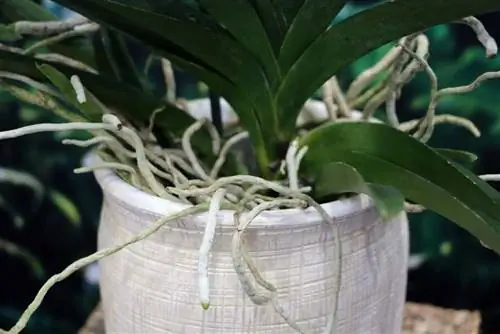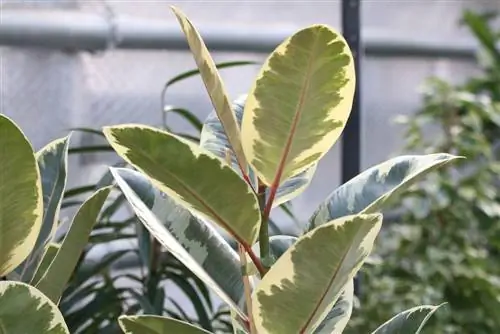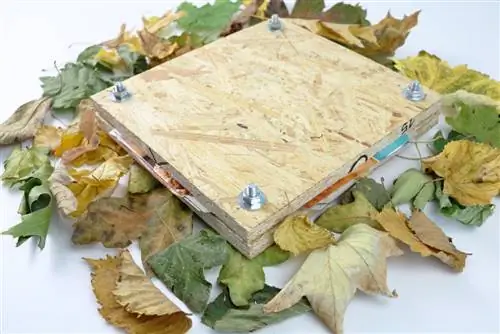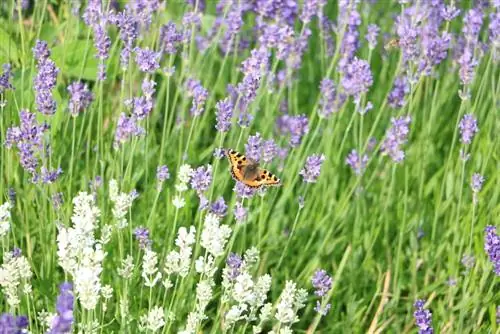- Author admin [email protected].
- Public 2023-12-17 03:39.
- Last modified 2025-01-24 12:45.
It happens without warning and leaves the affected hobby gardener at a loss. The previously magnificent orchid flowers dry up and fall off. As if that weren't enough, buds that have already been planted wither and are thrown off. No orchid genus is exempt from this crisis; Phalaenopsis are also caught up in it, as are Vanda and Cattleya. In this way, the exotic flower queens make it known that they are not at all comfortable with a circumstance. In view of this dilemma, you cannot avoid investigating the causes. Read here what helps!
Change location
Subject the location of your orchid to a dedicated inspection, because this is where the main causes of the flowers dropping can be discovered. If you clarify the following points, the problem may be resolved:
Avoid cold drafts
What was a given during the warm season becomes a problem in winter. If your orchids are located on a windowsill that is regularly ventilated, cold air will penetrate in winter. If a room door is open at the same time, the tropical flower suffers a cold shock as a result of the draft. She reacts to this by dropping the flowers and buds.
Tip:
If you buy an orchid during the winter, it is at risk of a cold shock on the way home. Ideally, a transparent box is available for transport. At the very least, the flower should be wrapped thickly in newspaper. Otherwise, the exotic treasure you have just purchased will be stripped of all floral decorations within a few days.
Prevent direct heating air
A location in the direct influence of rising heating air causes orchids to dry out and fall off their flowers. If the radiator in question cannot be turned off, relocate the plant. A decorative flower column in a bright location, for example, serves as an ideal alternative place during the winter.
Compensate for lack of light
In their tropical homeland, most orchid species thrive as epiphytes. In order to get as close to the light as possible, they hold on to the branches of treetops or rocks with their roots. The local lighting conditions from November to February therefore do not always meet the requirements. Since photosynthesis almost comes to a standstill under these circumstances, the flowers dry up and fall sadly to the ground. The same fate befalls buds that have already been planted. This helps:
- Put the orchid on the south window in winter
- Hang a daylight lamp or LED grow light above the flower
- Equipped energy-saving lamps with reflectors to optimize the light output
- Use fluorescent tubes for orchids with a similar height
Protect from the blazing midday sun
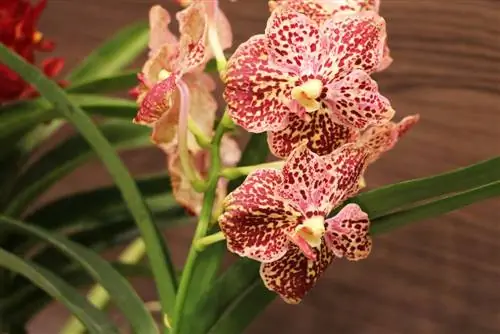
While light and sun are in short supply in winter, direct sunlight can pose problems during summer. If orchid flowers are exposed to the blazing rays of the sun for a long time without protection, they age prematurely and fall off. Shading on the balcony and terrace during midday is just as recommended as on the windowsill or in the winter garden.
Keep a sufficient distance from fruit baskets
Once ripening types of fruit, such as apples and pears, emit the ripening gas ethylene. This also influences orchid flowers if they are in close proximity to them. As a result, the aging process accelerates, the flowers dry out and are dropped prematurely. In this case, a distance of at least 1 meter will help to solve the problem.
Undo location change
If the misery only became apparent after a change of location, this itself could be the cause of the flower fall. Orchids are considered plants that are loyal to their location and find moving stressful. Therefore, only relocate the flower queens if it is unavoidable or if one of the previously explained problems could be a possible trigger. Otherwise, wait until the plant has acclimated to its new location or revise the change of location.
Failures in care
If a problem within the location issue could be ruled out as the cause, care becomes the focus of the investigation. Put the following factors to the test:
Fix water shortage
In the cultivation of plants, drying flowers are an unmistakable signal of a lack of water. Orchids are no exception. If sagging, shriveling leaves are added, the damage actually indicates an unsuitable water balance. This is how the plant comes back into balance:
- Never allow species and varieties without bulbs to dry out
- If in doubt, give the root ball a dipping bath
- The substrate should only dry until the next watering
- Orchids with bulbs are less common, but watered regularly
Within the countless breeds there are considerable differences in terms of water supply. Therefore, ask an experienced professional how to water your orchid correctly.
Increase humidity
Water balance goes hand in hand with maintaining appropriate humidity. If there are also deficits here - cumulative with the lack of water - the following measures can help:
- Fill the coaster with expanded clay and water
- The rising evaporation envelops the orchid flowers so that they do not dry out
- Ideally spray daily with lukewarm, lime-free water
- Set up electronic humidifiers in the immediate area
- In winter, place bowls filled with water on active radiators
Tip:
Take a look at the aerial roots to estimate the actual need for irrigation water. If they are still green, there is enough moisture. Silvery, shiny specimens indicate a lack of water.
Replace substrate
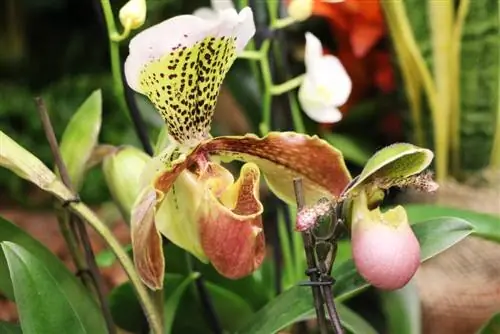
Within the broad orchid family, the vast majority develop aerial roots. Since the plants, as epiphytes, do not root in soil, they take moisture and nutrients from the air. Anyone who imposes conventional potting soil on exotic plants is literally cutting off the air from the roots. This is especially true if there is a large amount of peat involved. Nevertheless, the trade offers orchids in such potting soil, so that the orchid flowers dry out because the roots can no longer provide the supply. What helps now is immediate repotting in a special substrate. Here's how to do it:
- Water the orchid a day or two before and fertilize it a little
- Pot out the plant without strong pull
- If necessary, cut open the culture pot
- Remove the previous substrate as much as possible
- Cut out already suffering roots
- Create a drainage in the pot made of expanded clay
- Insert the orchid with a twisting motion
A mixture of pine bark, fine-grained humus, expanded clay or lava granules, some charcoal ash and sphagnum is suitable as a substrate. As you add the coarse soil in portions, tap the container repeatedly on the floor or tabletop to achieve even distribution. The flower is watered after 5 days at the earliest. The next dose of fertilizer will be administered after 4 weeks.
Tip:
To ensure that there are no insect eggs or fungal spores in the substrate, it is sterilized. In a heat-resistant dish, this can be done in the oven within 30 minutes at 180 degrees or in the microwave within 10 minutes at 800 watts.
Fighting pests
Their tropical origins do not protect orchids from attack by native pests. Primarily sucking and biting species weaken the flowers so much that they dry up and fall off. This is how you take action against the parasites:
- Wipe aphids with a damp cloth
- Then spray the leaves and flowers with the familiar soft soap solution
- Dab mealybugs and mealybugs repeatedly with alcohol-soaked cotton swabs
- Alternatively, spray the leaves with a mix of 10 ml spirit, 1 liter of water and 1 drop of dish soap
- Treat both the top and bottom sides
In any case, the affected plant should be isolated so that the pests do not migrate to the neighbors. If the orchids are in an enclosed space, the Australian ladybird beetle can be considered as a natural control agent. These are bred in specialist shops specifically for this use and are delivered in suitable containers.
Conclusion
When orchid flowers dry up and fall off, there is no reason to lose heart. Instead, look for the cause so that you can take appropriate countermeasures. Problems at the current location may have triggered the misery. What helps: avoid cold drafts, prevent direct heating air, eliminate a lack of light, protect from the blazing midday sun or avoid being in the immediate vicinity of a fruit basket. Additionally, lapses in care can cause the problem. Substrate that is too dry or humidity that is too low can easily be compensated for. If there is waterlogging or compacted substrate, immediate repotting should be considered. Last but not least, it is pests such as aphids, mealybugs and mealybugs that affect an orchid to such an extent that it drops its flowers.

